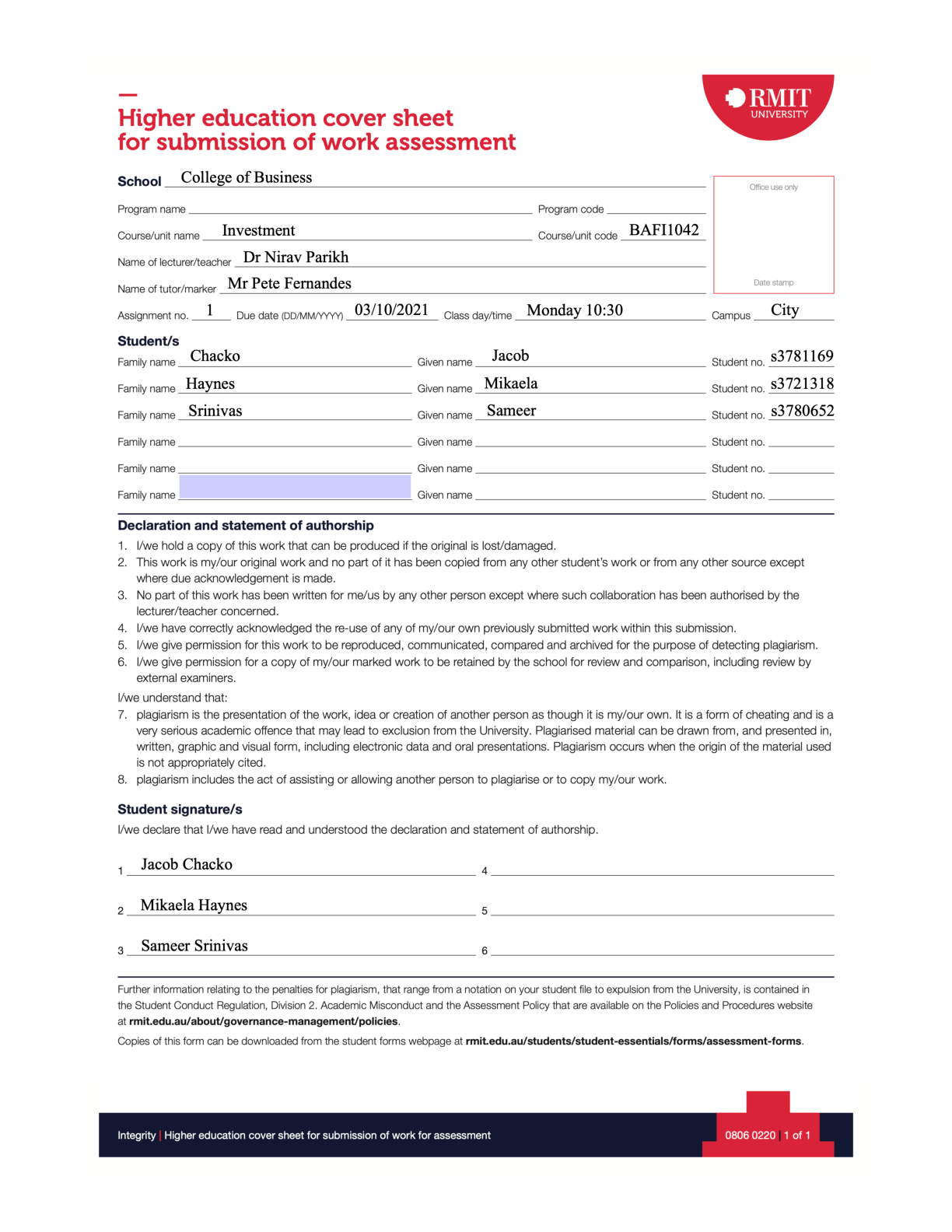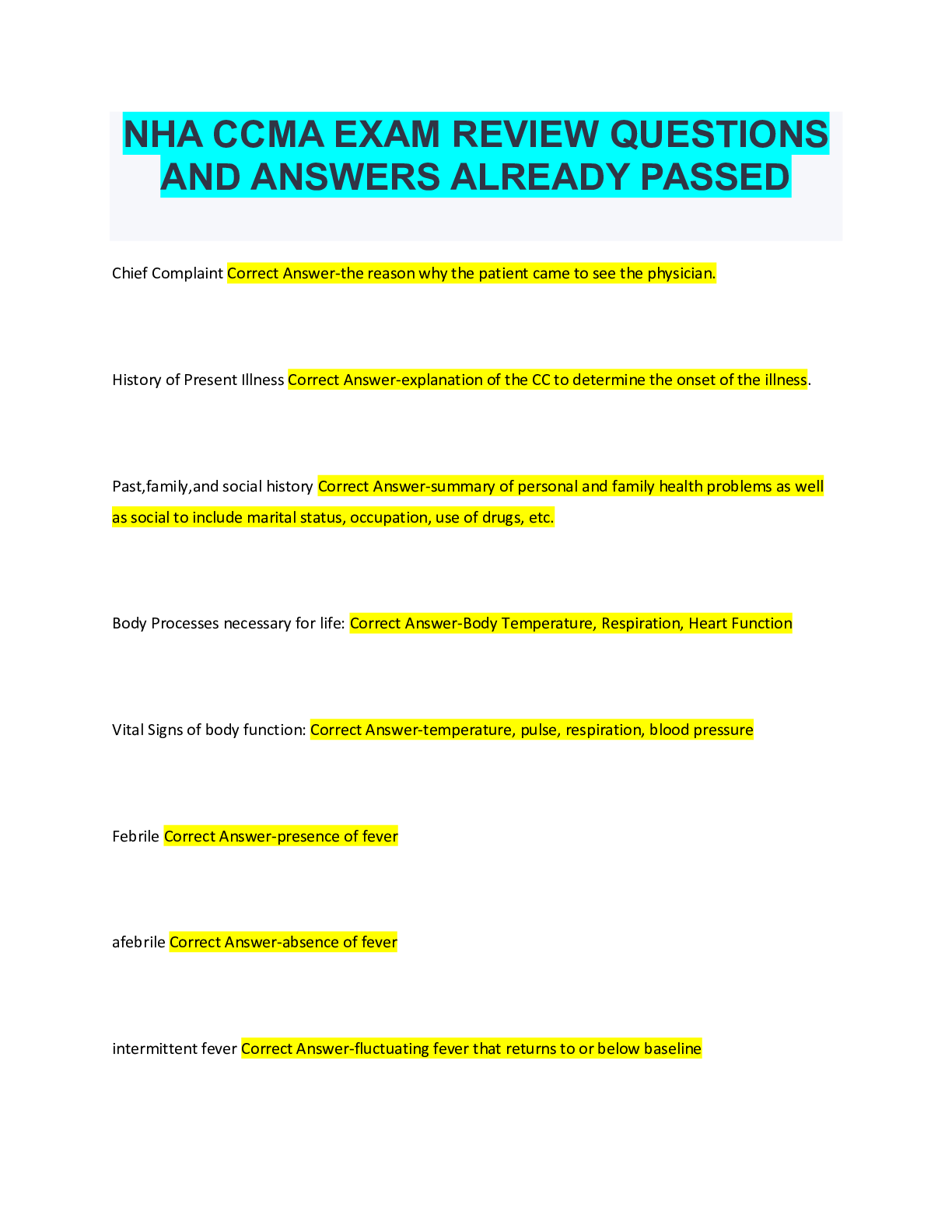
Integral_Diagnostics_Limited___Company_Valuation_Report___Group_Assignment_1.pdf.pdf
*NURSING > QUESTIONS & ANSWERS > NHA CCMA EXAM REVIEW QUESTIONS AND ANSWERS ALREADY PASSED. GRADED A+, 2022/2023 update. (All)
NHA CCMA EXAM REVIEW QUESTIONS AND ANSWERS ALREADY PASSED Chief Complaint Correct Answer-the reason why the patient came to see the physician. History of Present Illness Correct Answer-explanation ... of the CC to determine the onset of the illness. Past,family,and social history Correct Answer-summary of personal and family health problems as well as social to include marital status, occupation, use of drugs, etc. Body Processes necessary for life: Correct Answer-Body Temperature, Respiration, Heart Function Vital Signs of body function: Correct Answer-temperature, pulse, respiration, blood pressure Febrile Correct Answer-presence of fever afebrile Correct Answer-absence of fever intermittent fever Correct Answer-fluctuating fever that returns to or below baselineremittent fever Correct Answer-fluctuating fever that remains elevated and does not return to baseline continuous fever Correct Answer-fever that remains constant; does not fluctuate axillary temperature Correct Answer-least accurate; taken under the arm tympanic temperature Correct Answer-useful for children; placed in the ear rectal temperature Correct Answer-per rectum; most effective normal adult pulse range Correct Answer-between 60-100 bpm apical pulse Correct Answer-taken over the apex of the heart by auscultation normal respiration rate Correct Answer-12-20 per minute (Adults) apnea Correct Answer-temporary complete absence of breathing tachypnea Correct Answer-respiration rate greater than 40 per minutebradypnea Correct Answer-decrease in the numbers of respiration cheyne stokes Correct Answer-regular pattern of irregular breathing rate orthopnea Correct Answer-decrease in numbers of respiration hypoventilation Correct Answer-reduced amount of air enters the lungs resulting in decreased oxygen level hyperpnea Correct Answer-abnormal increase in the depth and rate of breathing hyperventilation Correct Answer-increased amount of air entering the lungs Systole Correct Answer-the highest amount of pressure exerted during the cardiac cycle Diastole Correct Answer-the lowest amount of pressure exerted during the cardiac cycle Palpation Correct Answer-the sense of touch to determine the characteristics of an organ systemPercussion Correct Answer-tapping or striking the body to determine the position, size and density of the underlying organ/tissue Auscultation Correct Answer-listening to sounds produced by internal organs Horizontal Recumbent Position Correct Answer-patient lies on back w/legs extended (used for most physical exams) Dorsal Recumbent Position Correct Answer-patient lies on back with knees flexed and soles of the feet flat on the bed Fowler's Position Correct Answer-semi/sitting position where back of the table is elevated. Dorsal Lithotomy Position Correct Answer-patient lies on back with knees flexed, legs seperated and thighs are acutely flexed. feet are usually in stirrups, Prone position Correct Answer-patients lies on abdomen with head turned to side Sim's position Correct Answer-patient lies on left side with right knee flexed against the abdomen and left knee slightly flexedknee-chest position Correct Answer-patient is on knees with chest resting on the bed and elbows resting on the bed above head OSHA Correct Answer-Occupational Safety and Health Administration external hemorrhage Correct Answer-controlling the bleeding is most effectively accomplished by elevating the affected part above heart level Shock Correct Answer-occurs when there is insufficient return of blood flow to the heart CPR Correct Answer-Cardiopulmonary Resuscitation AMS Correct Answer-Agent, Modes of Transmission, Susceptible Hosts agents Correct Answer-infectious microorganisms that can be classified into groups; viruses, bacteria, fungi, and parasites Portal of Exit Correct Answer-the method by which an infectious agent leaves the reservoir5 Modes of Transmission Correct Answer-Droplet, Airborne, Common Vehicle, Vectorborne, Contact (direct or indirect) Susceptible Host Correct Answer-Not Resistant or Immune Medical Asepsis Correct Answer-the destruction of pathogenic microorganisms after they leave the body disinfection Correct Answer-use of various chemicals that can be used to destroy many pathogenic microorganisms 1:10 Solution Correct Answer-most readily available and least expensive disenfectant surgical asepsis Correct Answer-all microbial life, pathogens and non pathogens are destroyed before an invasive procedure Gas Sterilization Correct Answer-often used for wheelchairs and hospital beds Dry Heat Sterilization Correct Answer-requires higher temperature than steam sterilization but longer exposure times Chemical Sterilization Correct Answer-use of the same chemical used for chemical disinfectionSteam Sterilization (autoclave) Correct Answer-uses steam under pressure to obtain high temperature of 250-254F with exposure of 20-40 min Handwashing Correct Answer-the most important means of preventing the spread of infection Personal Protective Equipment Correct Answer-Masks, goggles, face shileds, respirators isolation precautions Correct Answer-method of infection control that assumes all human blood and body fluids were potentially infectious standard precautions Correct Answer-designed to prevent direct contact with blood and other body fluids u using PPE transmission based precautions Correct Answer-the second tier of precautions are to be used when the patient is known or suspected of being contagious po Correct Answer-by mouth/orally pr Correct Answer-per rectumsl Correct Answer-sublingual (under the tongue) iv Correct Answer-intravenous im Correct Answer-intramuscular sq Correct Answer-subcutaneous qd Correct Answer-every day bid Correct Answer-twice a day tid Correct Answer-three times a day qid Correct Answer-four times a day pc Correct Answer-after meals / not on empty stomach qhs Correct Answer-each nightprn Correct Answer-as needed heart location Correct Answer-in the thoracic cavity between the lungs just behind the sternum Upper chambers of the heart Correct Answer-right & left atria (atrium-singular) Lower chambers of the hear Correct Answer-Right & left ventricles Endocardium Correct Answer-innermost layer of the heart Myocardium Correct Answer-middle layer of the heart Epicardium Correct Answer-outermost layer of the heart pericardium Correct Answer-the sac in which the heart is contained right atrium Correct Answer-receives deoxygenated blood returning to the heart via the superior vena cavaright ventricle Correct Answer-receives deoxygenated blood from the right atrium which it pumps to the lungs for oxygenation through the pulmonary artery pulmonary arteries Correct Answer-the only arteries in the body that carry deoxygenated blood left atrium Correct Answer-receives deoxygenated blood returning from the lungs via the rught and left pulmonary veins pulmonary veins Correct Answer-the only beins in the body that carry oxygenated blood left ventricle Correct Answer-receives the oxygenated blood from the left atrium and pumps it to the body through the aorta aorta Correct Answer-the largest artery of the body Atrioventicular Valves (AV) Correct Answer-Tricuspid & Mitral Valve Tricuspid Valve Correct Answer-;between the right atrium and the right ventricleMitral Valve Correct Answer-between the left atrium and left ventricle Pulmonic Valve Correct Answer-between the right ventricle and pulmonary trunk Aortic Valve Correct Answer-between the left ventricle and aorta Murmurs Correct Answer-caused by diseases of the valves or other structural abnormalities S1 Correct Answer-first heart sound S2 Correct Answer-second heart sound Autonomic Nervous System (ANS) Correct Answer-subdivided into Sympathetic and Parasympathetic systems ANS Correct Answer-Automatic Nervous System [Show More]
Last updated: 3 years ago
Preview 1 out of 24 pages

Buy this document to get the full access instantly
Instant Download Access after purchase
Buy NowInstant download
We Accept:


Down load this bundle for easy revisions. ALL LATEST VERSIONS, OVER 2000 EXAM QUESTIONS WITH ACCURATE ANSWERS, VERIFIED.
By bundleHub Solution guider 2 years ago
$32
57

by Jay Williams · 2 years ago
Can't find what you want? Try our AI powered Search
Connected school, study & course
About the document
Uploaded On
Sep 08, 2022
Number of pages
24
Written in
All

This document has been written for:
Uploaded
Sep 08, 2022
Downloads
3
Views
717
Scholarfriends.com Online Platform by Browsegrades Inc. 651N South Broad St, Middletown DE. United States.
We're available through e-mail, Twitter, Facebook, and live chat.
FAQ
Questions? Leave a message!
Copyright © Scholarfriends · High quality services·